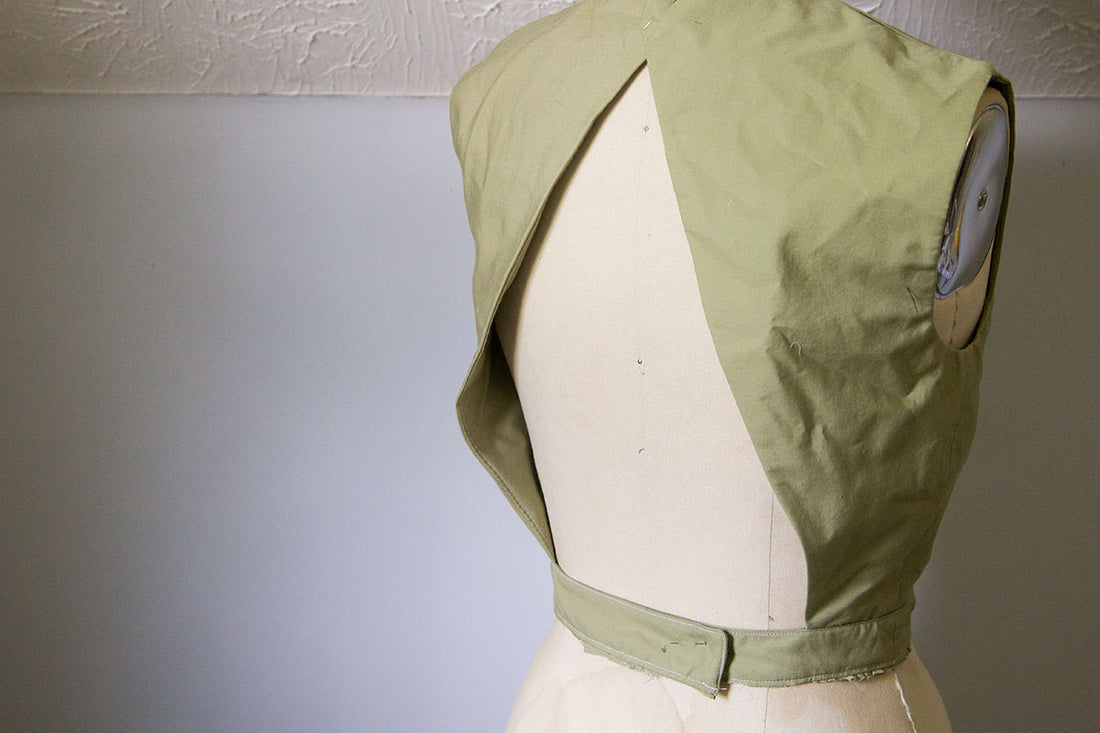Have you ever been so excited by a lovely V-neck backed garment, or potentially an open back garment -- or any garment that has a steep V-shape of any kind really -- and gone through the process of sewing it all up only to realize that it gapes? I mean, it's wearable, and you love it and everything, but maybe for the second version, you'd prefer the garment to fit a bit more closely to your body?
If this describes you at all, then welcome to the club! I have been there, I have struggled with gaping backs all my sewing life, but I have great news- it's really easy to fix this issue BEFORE you even cut out your precious fabric (yay!)
That means no more weird, random darts that you have added to your necklines in an attempt to make your garment fit a little bit better *Ahem me 100%* Below, I will be taking you step-by-step on two separate ways to alter your gaping back issue.
There is also a really fantastic video tutorial on adjusting gaping back via Handmade by Ditsy Tulip if video's are more your jam! You can check it out HERE.
Her way of tackling this problem is awesome if you happen to have a dart on your pattern- I will talk a little about transferring some excess ease to darts below, but she goes into better detail!
Ok, Let's Get Started!
First off, you'll want to identify exactly how much the back of your garment is gaping. You may want to grab a friend to help if you don't have a mannequin! You can also do this yourself with the help of a mirror, some pins, and a LOT of patience. When I was working on the Amelie Dress pattern, I tested it on my own body (since my dress form isn't a human that moves) and it was really funny watching me pin myself into my garment.


Put your garment on yourself (or mannequin) and pin out the gaping bits in roughly the same place on either side of your garment. You want to pick a spot that causes the least amount of change in the overall shape of your design. That is why for my garment, I tried to pin out as close to the top of the neckline as I could.


Next, you'll want to mark where your pins are. This is when working with a toile or muslin really comes in handy! I just grabbed a permanent marker and went to town on marking up my garment.
You'll also want to make not of how far the excess seems to extend. Does it go all the way to your armhole? Or does it stop halfway through your back bodice? If it stops halfway through your bodice, mark a little point where there is no more excess fabric.


Remove your pins and lay your bodice back as flat as you can on a smooth surface. We are now going to measure two things: how far down our markings are from the neckline and how wide our markings are from one another.

 Again, I just went to town with my marker, making little notes all over the toile.
Again, I just went to town with my marker, making little notes all over the toile.
At this point, which method you use to remove that excess gape at the back of your garment depends on whether it extended all the way to the armhole or only halfway through the bodice back.
Excess Fabric to Armhole
Please note that I am working with a mini-version of my pattern piece to show the techniques needed for this alteration.
We are now going to grab your back bodice pattern piece. Make sure you are working with a traced version of your pattern as we will be slashing into this to *hopefully* achieve the perfect fit. I would hate for you to ruin your original copy of the pattern in case you ever wanted to go back and try a new technique later on!

Measure from your neck down the same distance that you measured on your physical sample. Mark your pattern with a little dash. Then measure the same width of the "dart" you pinched out while your bodice was on and make a second dash.

With a ruler, extend those little dashes to a single point on your armhole. This doesn't have to be precisely perfect. Just aim for where your fabric was billowing while you were wearing it.


You should have something that resembles a very long dart going across your pattern piece. And we are going to treat it just like a dart for this next step! Bring your two "dart" legs together and crease the center line of your "dart" together; tape this newly joined bit down.

You can probably see a bit better on your life sized pattern that everything look just a bit wonky. You are going to want to true up your pattern, which simply means to make it “true” (AKA complete and correct). Go ahead and smooth out your armhole curve and straighten out your new back lines as well as redraw your grainline.

Woot! Now you have a new pattern that should be much closer (if not right on the money) to fitting your unique shape! I always suggest making a second toile at this point, just to make sure you took enough of the excess out.
Don't be discouraged if this new pattern needs some further tweaking. It took me 5 attempts before I got the Amelie to fit exactly how I wanted!
Excess Fabric Halfway Through Bodice
Please note that I am working with a mini-version of my pattern piece to show the techniques needed for this alteration.
We are now going to grab your back bodice pattern piece. Make sure you are working with a traced version of your pattern as we will be slashing into this to *hopefully* achieve the perfect fit. I would hate for you to ruin your original copy of the pattern in case you ever wanted to go back and try a new technique later on!

Measure from your neck down the same distance that you measured on your physical sample. Mark your pattern with a little dash. Then measure the same width of the "dart" you pinched out while your bodice was on and make a second dash.

Using your marked up, real-life garment as a guide, measure approximately how far the point you made on your garment (where the excess fabric ended) is from your little dash points. Go ahead and transfer that mark to your pattern piece.
Then, with a ruler, extend those little dashes to that single point you just marked.

You should have something that resembles a short dart extending into your pattern piece. And we are going to treat it just like a dart for this next step! Bring your two "dart" legs together and crease the center line of your "dart" together; tape this newly joined bit down.


You'll notice that unlike with the previous alteration (where the "dart" extended all the way to your armhole), this alteration creates a big pucker in the back of your garment. Not exactly ideal, unless you are going for a geometric look, in which case, yay! You are done and can stop here.
For everyone else, we want to transfer this excess ease someplace. If you have a dart already drafted in your pattern piece, you can simply slash through your dart and transfer that excess ease into the dart, making it a bit wider.
If you don't have a dart, you have two options:
1) You can slash through your pattern at any given point you wish and create a dart. You could do this at either the shoulder seam or the waist seam as those are the most common places for a back bodice dart.

Or 2) You can slash a few more times and spread the ease around your pattern. This works best if the amount you are taking out of the back bodice is less than 1.5" / 3.8 cm.

You want to try to keep your newly spread pieces to be less than 1/4" large. This way they can still easily be eased into your front bodice pieces if necessary!
You are going to want to true up your pattern, which simply means to make it “true” (AKA complete and correct). Tape your pattern piece to a new sheet of paper and smooth out your armhole curve and straighten out your new back lines. You should also redraw your grainline.
 I went ahead and took out the same amount I added in ease from the neckline. That way I didn't wind up with a gaping back neck at the top!
I went ahead and took out the same amount I added in ease from the neckline. That way I didn't wind up with a gaping back neck at the top!

Woot! Now you have a new pattern that should be much closer (if not right on the money) to fitting your unique shape! I always suggest making a second toile at this point, just to make sure you took enough of the excess out.
Don't be discouraged if this new pattern needs some further tweaking. It took me 5 attempts before I got the Amelie to fit exactly how I wanted!
I hope one of these three tutorials helps you achieve your perfectly fitted bodice back, no matter what project you might be working on!



 Again, I just went to town with my marker, making little notes all over the toile.
Again, I just went to town with my marker, making little notes all over the toile.
 I went ahead and took out the same amount I added in ease from the neckline. That way I didn't wind up with a gaping back neck at the top!
I went ahead and took out the same amount I added in ease from the neckline. That way I didn't wind up with a gaping back neck at the top!